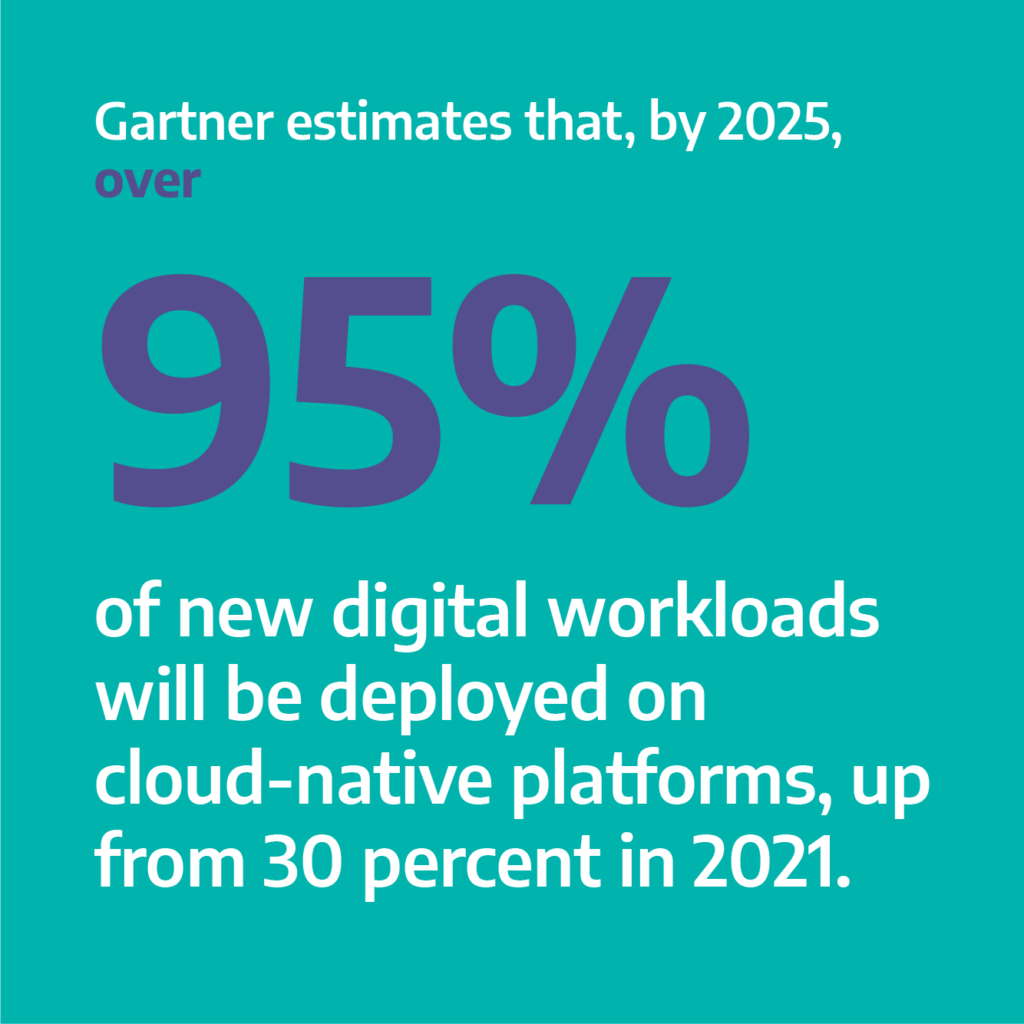
Cloud computing adoption has been rapidly increasing during the pandemic, and its popularity will keep on growing over the next few years because it can support remote work and reduce time to market and upfront investment. Gartner analysts note that more than 85 percent of organizations will embrace cloud-first principles by 2025, and won’t be able to fully execute their digital strategies without using cloud-native architecture and technology.
Gartner estimates that, by 2025, over 95 percent of new digital workloads will be deployed on cloud-native platforms, up from 30 percent in 2021.
However, moving infrastructure and applications from on-premise data centers with internal servers to a cloud environment is challenging, due to the complexity of the various applications and platforms involved, as well as the need to conduct an accurate data migration. According to a survey of 400 IT professionals conducted by iLand, 43 percent of their migrations to Microsoft Azure failed as did 57 percent of migrations to Amazon Web Services.
During the transition period, maintaining a reliable infrastructure is critical; you must prevent disruption, system failure, or discontinuity of IT.
Baseline performance is key
Performance visibility is critical during three steps in any network migration to the cloud.
1. Magnify. This initially involves establishing a baseline of performance for your current applications. That means understanding customer usage patterns, overall bandwidth consumption, and application performance, as well as getting a handle on the overall level of complexity and distribution.
2. Migrate. During migration, you need to understand how the performance of cloud applications relates to the baseline you’ve established. In order to inspire confidence in your users during the transition to the cloud platform, you must be proactive in addressing any performance issues.
3. Monitor. After the migration phase is over, you must keep on monitoring the performance of cloud applications and address performance issues. You should isolate problems to determine if they’re caused by the cloud provider, network, or application, and monitor application service level agreements (SLAs) in order to understand the impact of cloud technology changes and drivers of cloud hosting costs.

Blind spots: The biggest challenge
The shift from on-premise IT infrastructure to the cloud leads to blind spots and specifically network visibility gaps for application and network performance. These gaps begin the moment network migration to the cloud does. The challenge is that most traditional network performance monitoring tools don’t work in the cloud. Trying to adapt outdated tools for use in the cloud leads to unacceptable network performance monitoring costs.
The overall costs for monitoring a widespread environment using traditional tools would escalate quickly and lead to increased operating costs and significantly higher total cost of ownership (TCO). These increases could wipe out the savings gained by moving infrastructure to the cloud. Different traffic visibility architectures lead to very different network performance monitoring costs.
According to Vision Solutions, 51 percent of migrations fail, and these blind spots are one of the major reasons for those failures. Migrating to the cloud can affect business-critical operations, as IT cannot see the end user’s experience. Forrester says 31 percent of performance issues take more than a month to resolve or are never resolved at all because IT cannot identify the source of the problem because they lack application and network visibility.
Businesses must gain back control and demand high-definition visibility at all stages of migration to the cloud.
Real-time network and application monitoring tools that go beyond on-premise infrastructure and into the cloud environment can help reduce blind spots during and after migration. These tools enable businesses to meet SLA user experience benchmarks. Poor end-user experience will invariably lead to churn, which has a direct impact on revenue and reputation.
Accedian’s Skylight provides high-definition visibility across applications and the network, from all sources of data. It delivers performance metrics within minutes and can monitor application workloads before, during, and after cloud migration. It also evaluates application behavior for multiple implementation options and monitors performance all the way through ramp-up and beyond.
Skylight cloud monitoring configuration costs between 300 and 900 percent less than comparable competitive configurations for cloud and on-premises configurations. A network architect at a recruiting/HR firm with more than 500 employees said Skylight prevented the company from buying a few servers that they simply didn’t need.
Six steps for successful cloud migrations
Accedian has deep experience in helping companies move to the cloud. Here are some tips for a successful migration:
- Define business goals for the migration and map those goals to IT capabilities and constraints, such as compliance. Involve all stakeholders in the process.
- Discover, catalog, and select applications by identifying all that are currently in use and then qualifying them for the cloud. Get a performance baseline and map all dependencies.
- Specify the type of migration you want to make for each application. Will you be simply rehosting an app in the cloud? Hosting it and making minor changes? Repurchasing it as a SaaS offering? Rewriting parts of it? Replacing it entirely?
- Test and refine the process by comparing on-prem and cloud app behavior. Test multiple implementation options, resolve problems, then fine-tune.
- Migrate the infrastructure, and the application workload, then do final testing.
- Monitor performance optimization. Keep resolution time under control, manage vendor performance and costs, and strive to meet mandated end user experience performance goals.
For more on cloud migration, learn how Accedian Skylight can help.

 Improved delivery, better visibility: How Accedian and VMware are working together to help CSPs navigate the 5G world
Improved delivery, better visibility: How Accedian and VMware are working together to help CSPs navigate the 5G world
 Adding a new dimension of visibility to the Cisco Full-Stack Observability portfolio with Accedian Skylight
Adding a new dimension of visibility to the Cisco Full-Stack Observability portfolio with Accedian Skylight